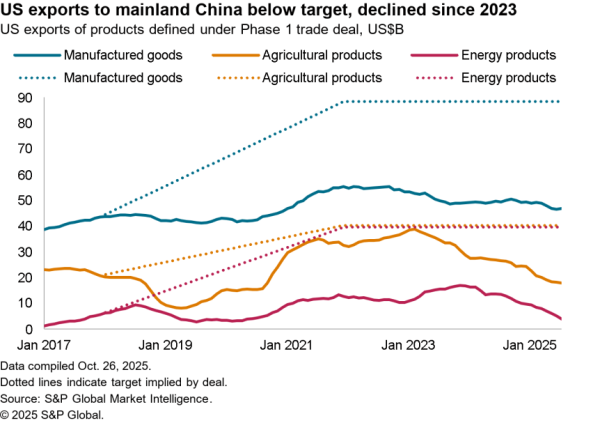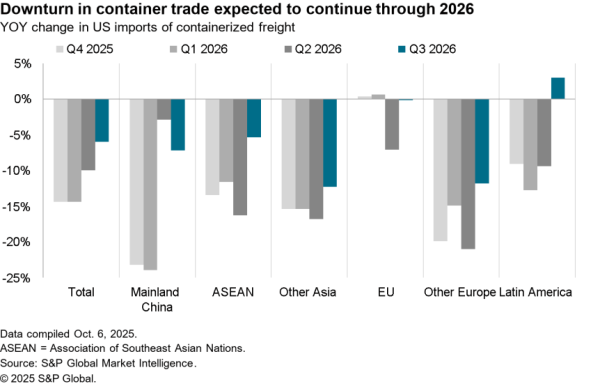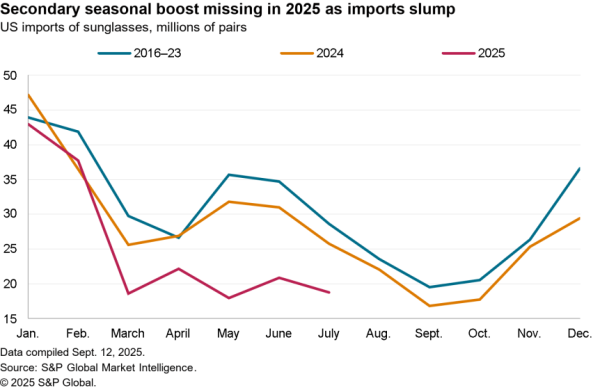Panjiva Research took part in a webinar on May 18, “Latin America versus The World: Life after the Pandemic” alongside our colleagues from S&P Global Ratings and S&P Global Platts. The report provides a recap of the key topics covered as well as the result of two audience polls. A full replay is available here.
Global trade activity has recovered to pre-pandemic levels already with global exports having increased by 24.1% year over year in March and by 14.4% compared to March 2019, Panjiva’s analysis of macroeconomic data shows. In broad-brush terms that’s been driven by consumer demand in North America and Western Europe fed by manufacturing in Asia that has utilized commodity supplies from Latin America.
Exports in the big four Latin American markets all grew at double digit rates in March 2021 versus March 2019, including a 10.2% rise in exports from Mexico and a 38.4% jump in shipments from Brazil.

Source: Panjiva
Exports from Brazil have been helped by a surge in commodity prices across the agricultural, energy and metals / mining sectors. Mexico meanwhile has seen a more mixed performance. The recovery in oil prices versus a year earlier meant that Mexican oil exports rose by 61.7% year over year, Panjiva’s data shows, though that only placed exports 5.3% above 2019 levels.
The automotive sector – key to Mexico’s economic development – has seen a mixed performance with exports of cars down by 30.3% year over year and light trucks down by 1.8% due to an ongoing shortage of parts, as discussed in Panjiva’s research of May 7. The global imbalance in availability of semiconductors has been to blame with exports of PCs and network equipment up by 11.6% and 20.8% respectively.

Source: Panjiva
Looking ahead, a full recovery of the Latin American economies is likely to take an extended period. On the energy side S&P Global Platts expects strong global demand for oil products in mid-2021 with supply only catching up in Q4’21. S&P Global Ratings meanwhile noted that their forecasts call for a recovery to pre-pandemic levels in Q1’22 for Brazil, Q2’22 for Chile, Q4’22 for Mexico and as late as Q3’23 for Argentina.
Our audience was asked “How long do you think it will take most Latin American countries’ economic activity to return to pre-pandemic levels?“. The majority (56.6%) expect a recovery only in 2022 with a further third (33.0%) seeing a recovery taking until beyond 2022.

Source: Panjiva
One of the keys to economic recovery is the rollout of COVID-19 vaccines. The decision by India’s Serum Institute to limit exports of COVID-19 vaccines until the end of 2021 could have a significantly negative impact on the rollout in Latin America, as discussed in Panjiva’s research of May 19. That will leave most Latin American countries even more reliant on supplies from China and Russia in the near-term.
A promise of 80 million doses to be delivered from the U.S. may be a partial help, but a concerted push to support extended manufacturing – and not just relaxed intellectual property rules – is needed. In the meantime, Mexican imports of vaccines increased by 104% in March versus the prior three months’ average, with 39.2% of imports accounted for by AstraZeneca and Pfizer.

Source: Panjiva
The recovery of Latin America’s economies in the longer term will also depend on the potential to shift beyond being commodity suppliers to also being manufacturers of components and completed products.
In that regard the region may be in a worse position than before the pandemic, with the EU, U.S., India and China all having recently outlined new, potentially heavily funded industrial onshoring strategies. The challenges faced during the semiconductor shortage and problems faced by the automotive industry as a result have underscored for many governments the need to support onshoring.
One challenge faced by supply chains in the region has been volatility in supplies during the pandemic. Panjiva’s data shows Brazilian automotive parts imports are experiencing a surge in imports with total imports up by 65.1% year over year and by 62.7% versus March 2019. Volkswagen has seen the fastest rate of growth at 94.5% year over year and by 59.3% compared to 2019 while Renault has cut its shipments aggressively in March, by 60.8% year over year, after expanding earlier in Q1.

Source: Panjiva
One area of potential development in autos though comes in the shift from fossil-fuelled internal combustion engines to renewable energy and electrification. S&P Global Platts noted that current expense of most models combined with cheap availability of biofuels in Brazil may limit the appeal of electric vehicles in the mid-term.
Similarly, the supply chain shift towards simpler vehicles in the case of electricity and the importance of integrated battery manufacturing could prove a challenge. Chile has significant lithium resources, with exports that climbed 35.5% year over year in the three months to Feb. 28. The country faces a challenge from volatile prices, however, with average achieved lithium export prices reached $5,858 per ton in the three months to Feb. 28 from $10,280 per ton in June 2020 despite a rebound in the month of February.
There’s a clear incentive for the government to pursue a move further down the value chain. Yet, it will likely struggle to outbid the U.S. / Mexico for battery manufacturing facilities. That may limit the opportunity to expand the regional automotive sector and may eventually create challenges for production in the region, particularly in Brazil.

Source: Panjiva
In light of the challenges facing autos, we asked the audience “Which of the following industries have the most exciting growth opportunities in Latin America in the next three years?“. The most popular industries by far were agriculture with 38.3% of votes and renewable energy with 27.2%. The latter likely includes the feedstock crops for renewables as well as the technologies for wind and solar. The low proportion of respondents highlighting electronics (11%), capital goods (4.9%) and autos (2.5%) would suggest little optimism that Latin American supply chains will be able to develop towards manufacturing rather than remaining at the commodity level.

Source: Panjiva




